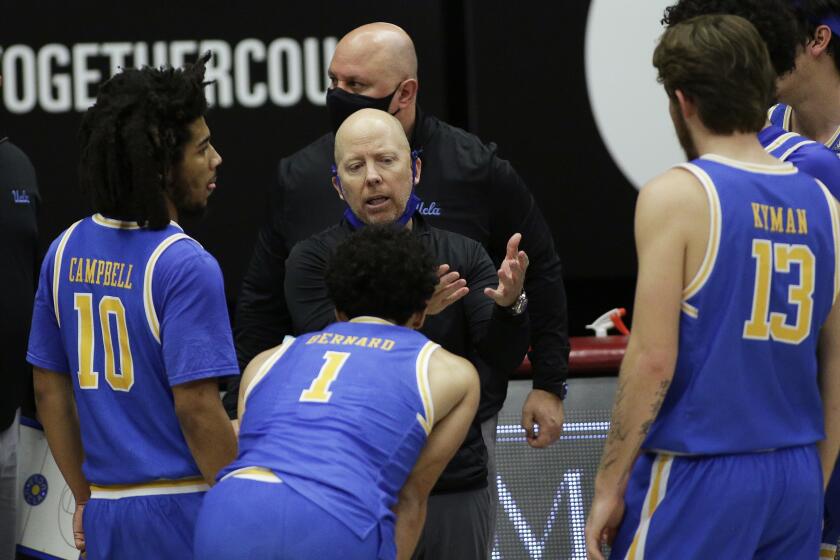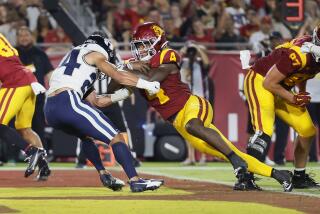Their rebuild a success, USC and Andy Enfield seek more in postseason

- Share via
Last spring, as Andy Enfield took stock of where USC stood at the painfully sudden end of its season, the Trojans’ coach couldn’t help but feel a bit concerned.
The two winningest players in program history were graduating. Onyeka Okongwu was off to the NBA. Two graduate transfers had exhausted their eligibility. And two more unexpectedly announced their intent to transfer. That left Enfield with just three returners to go with top recruit Evan Mobley.
“We didn’t even have enough players to play a college basketball game,” Enfield says now, with a laugh.
The journey from that moment last March to the present, with USC on the precipice of its most anticipated postseason in years, marks Enfield’s most impressive work in his eight seasons at the helm, a feat of sudden roster construction and coaching that earned him Pac-12 coach of the year honors. What began with a threadbare depth chart amid the backdrop of a pandemic offseason turned into USC’s most promising basketball campaign in recent memory, one that could extend into late March.
No one expected such a run at the start of this season, when the media picked the Trojans to finish sixth in the Pac-12. Now as USC’s postseason pursuit begins Thursday in a Pac-12 quarterfinal matchup against Utah in Las Vegas, Enfield admits he’s not even sure what to expect.
“We don’t have a single player on the team that’s played in the Pac-12 tournament, and we have just one that’s been in the NCAA tournament,” Enfield said. “So it’s going to be an exciting couple weeks here.”
Arizona State beat Washington State while Utah held off Washington in the opening round of the Pac-12 Conference tournament.
He compared the feeling to last October when, after months spent waiting out a lockdown, USC was cleared to practice indoors as a team. Some programs had been working together since July. But the rebuilt Trojans, pieced together largely by way of the transfer portal, had never been on the same court because of COVID-19 guidelines. Half the team had committed to USC without visiting campus.
“We weren’t sure how this team would react when the season started,” Enfield said. “They had never played one game together. We had a lot of unproven players that hadn’t been relied upon at the Pac-12 level.”
Each transfer wound up playing an integral role in a season in which USC (21-6 overall and 15-5 in the Pac-12) finished with its highest winning percentage of the Enfield era (.778), while winning more games than any other conference team, including Pac-12 champion Oregon.
Tahj Eaddy arrived from Santa Clara and became the engine of USC’s inside-out offense. Drew Peterson (Rice) and Isaiah White (Utah Valley) emerged as starters and key defensive pieces, while Chevez Goodwin (Wofford) filled a crucial bench role, all in spite of an offseason that made such transitions particularly tricky.
It helped to have a star 7-footer in the middle, binding together both sides of the ball, and it’ll take a heroic effort from Mobley this March for USC to make serious waves this week and in the NCAA tournament. In two meetings with Utah this season, Mobley was held in check, attempting seven shots and scoring a combined 14 points.

But it’s the others around him that will ultimately have to keep USC afloat, especially after Mobley wore down over the final two weeks of the season. There’s a reason the Trojans are 18-0 when three players score in double figures, and 3-6 when they don’t.
“In a year like this, where it’s tough to build that chemistry, it could’ve easily not worked,” Eaddy said. “But it’s the talent level on this team. If we weren’t as talented, it would take longer for us to get adjusted. Maybe we wouldn’t have gotten this far.”
The question now is whether that talent will translate to the postseason, where Enfield has yet to truly prove himself as USC’s coach. In seven seasons, Enfield has guided USC to the NCAA tournament twice, never getting past the first weekend. But he’s quick to point out that two of those seasons were spent rebuilding a downtrodden program, while last March, USC was denied of what he believes could’ve been a prolonged run.
UCLA opens play in the Pac-12 tournament Thursday against Oregon State on a losing streak, but coach Mick Cronin wants the Bruins to keep fighting.
Enfield is often armed with statistical proof of his program’s progress, like how USC has won 20 or more games in five of his last six seasons or how only Baylor and Kansas have won more games over the last two years among major conference teams.
A deep postseason run — or even a trip to the tournament’s second weekend — would go a long way in validating those claims. But after the season he and USC have had, Enfield insists they don’t need any such validation.
“Postseason success means a lot for programs, especially programs like USC, which hasn’t had much,” Enfield said. “We’d certainly like to add to that. But that’s not crossing our minds right now. We’re just happy to have the opportunity we have in front of us.”
More to Read
Fight on! Are you a true Trojans fan?
Get our Times of Troy newsletter for USC insights, news and much more.
You may occasionally receive promotional content from the Los Angeles Times.









